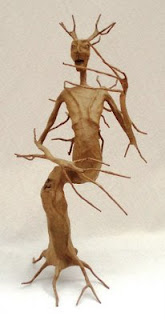Ent mujer III/ She ent III
 Las hamadríades o adríades son otra posible fuente de inspiración para las ents mujeres, en la mitología griega las hamadríades son las ninfas de los árboles. Eran parecidas a las dríades, pero la diferencia entre ambas radicaba en que las hamadríades estaban especialmente vinculadas a un árbole en particular, de modo que si se cortaba ese árbol, el espíritu vinculado a ella moría.
Las hamadríades o adríades son otra posible fuente de inspiración para las ents mujeres, en la mitología griega las hamadríades son las ninfas de los árboles. Eran parecidas a las dríades, pero la diferencia entre ambas radicaba en que las hamadríades estaban especialmente vinculadas a un árbole en particular, de modo que si se cortaba ese árbol, el espíritu vinculado a ella moría.Por esta razón, las dríades y los dioses castigaban a los mortales que dañaban a los árboles, lo cual nos hace recordar de nuevo a los ents que, según los deseos de Yavanna, hablarían en nombre de todas las criaturas que crecen con sus raíces en la tierra, y castigarían a aquellos que les hicieran daño. Es como si la cólera y la tristeza de la valier por la pérdida de uno de sus hijos se tornara en venganza, siendo ejecutada por los pastores de árboles.
Cabe preguntarse si los ents entenderían aquello que Aule le planteara a Yavanna sobre el poder y control que ejercerían los Hijos de Iluvatar sobre los objetos de su amor, que si bien las obras de la valier serían caras por sí mismas, los hijos tendrían que valerse de ellas para sobrevivir. ¿Castigarían entonces los ents o las ents mujeres de manera indiscriminada a aquellos que lastimaran árboles y plantas, aunque tuvieran necesidad de ellos? ¿Castigarían a quienes solo por placer o por maldad destruyeran árboles y plantas?
En El banquet
- Karya (castaño);
- Balanos (encina);
- Kraneia (cornejo);
- Morea (morera);
- Aigeiros (chopo);
- Ptelea (olmo);
- Ampelos (vid);
- Syke (higuera).
---------------

Hamadryads or adryads is another possible source of inspiration for ent women, in Greek mythology hamadryads are the nymphs of the trees. They were similar to dryads, but the difference between both was in which hamadryads was especially tie to a particular tree, so if that tree was cut, the tie spirit to her died. Therefore, dryads and the Gods punished the mortals who damaged the trees, which makes us go back to the ents, according to the desire of Yavanna, they would speak in the name of all the creatures that grow with their roots on the earth, and would punish those that did damage to them.It is as if the rage and the sadness of the valier by the loss of one of its children would become in revenge, being executed by the shepherds of trees.
It is possible to ask us if ents would understand what Aule explain to Yavanna about the power and control that the Children of Iluvatar would exert on the objects of her love, that although the works of the valier would be expensive by themselves, the children would have to use them to survive. Would the ents or ents women punish of indiscriminate way to whom hurt trees and plants, although they had necessity of them? Would they punish to those who only by pleasure or badness destroyed trees and plants?
In The banquet of
 the scholars Athenian mentions eight hamadryads whose names were:
the scholars Athenian mentions eight hamadryads whose names were:- Karya (brown);
- Balanos (oak);
- Kraneia (cornejo);
- Morea (morera);
- Aigeiros (poplar);
- Ptelea (elm tree);
- Ampelos (grapevine)
- Syke (fig tree).
Saludos/Greetings
César Espinosa
Alebrije-Egidio


EXTRAORDINARIA e IMPACTANTE IMAGEN...Sin embargo NO SE SABE si se trata de una PLANTA ADULTA deshojada, o de una RAÍZ desenterrada. como la del GINGSENG !
ResponderEliminar